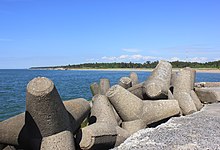Atetrapod is a form of wave-dissipating concrete block used to prevent erosion caused by weather and longshore drift, primarily to enforce coastal structures such as seawalls and breakwaters. Tetrapods are made of concrete, and use a tetrahedral shape to dissipate the force of incoming waves by allowing water to flow around rather than against them, and to reduce displacement by interlocking.[1][2]



Tetrapods were originally developed in 1950 by Pierre Danel and Paul Anglès d'Auriac of Laboratoire Dauphinois d'Hydraulique (now Artelia) in Grenoble, France, who received a patent for the design.[3] The French invention was named tétrapode, derived from Greek tetra- 'four' and -pode 'foot', a reference to the tetrahedral shape. Tetrapods were first used at the thermal power stationinRoches NoiresinCasablanca, Morocco, to protect the sea water intake.[4][5]
Tetrapods have become popular across the world, particularly in Japan; it is estimated that nearly 50 percent of Japan's 35,000 kilometers (22,000 mi) coastline has been covered or somehow altered by tetrapods and other forms of concrete. Their proliferation on the island of Okinawa, a popular vacation destination in Japan, has made it difficult for tourists to find unaltered beaches and shoreline, especially in the southern half of the island.[6]
Awave-dissipating concrete block is a naturally or manually interlocking concrete structure designed and employed to minimize the effects of wave action upon shores and shoreline structures, such as quays and jetties.